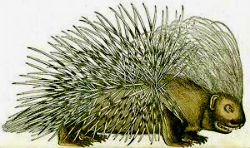Porcupine Hybrids
Families Erethizontidae and Hystricidae
EUGENE M. MCCARTHY, PHD GENETICS, ΦΒΚ
Porcupine Hybrids - Reported crosses:

Atherus sp.[Old World Brushtailed Porcupine]
+ Coendou sp.(♂) [New World Tree Porcupine] Morris (1970, p. 502) says attempted copulation was repeatedly observed between a caged pair, even though a Coendou femalewas present. No hybrid resulted.
Coendou insidiosus [Bahia Porcupine]
× Coendou spinosus [Paraguay Hairy Dwarf Porcupine] NHR(Brazil). Emmons and Freer (1997, pp. 216-223) described a probable hybrid collected in the state of Espírito Santo, and suggested that a hybrid zone is present in that region.
Coendou spinosus [Paraguay Hairy Dwarf Porcupine] See: Coendou insidiosus.
Hystrix africaeaustralis [Cape Porcupine]
× Hystrix cristata [Crested Porcupine] CHR. DRS. Gray (1972, p. 86) says two hybrids were born at the London Zoo in 1918 and cites “Zoological Society of London.” The Zoochat website says that porcupines with the characteristics of both crested and cape were living at Omuta City Zoo (Japan) in 2018.
Hystrix brachyura[Malayan Porcupine]
× Hystrix cristata(♀) [Crested Porcupine] CHR. DRS. Listed cross was H. brachyura × H. galeata, but galeata is now usually included in H. cristata. International Zoo Yearbook 1975 (p. 369).
Hystrix cristata[Crested Porcupine]
See also: Hystrix africaeaustralis; H. brachyura.
× Hystrix indica[Indian Crested Porcupine] CHR. ENHI. From each of two litters of five hybrids, born in 1967 and 1968 at the London Zoo, three hybrids survived. A population (hirsutirostris) geographically intermediate (northern Iraq and Caucasus to India) and has been treated as a race of both H. cristata and H. indica. It is thus a PHP of this cross. Chernova and Kuznetsov 2001 (p. 378); Corbet 1978 (p. 159); Gulland et al. 1987; International Zoo Yearbook 1969 (p. 225), 1970 (p. 259), 1977 (p. 311).
× Hystrix javanica (♂)[Sunda Porcupine] CANHR. Flower (1929a, p. 221) lists this cross as having occurred in the Surrey Zoological Gardens prior to 1847. In connection with this specimen, which was preserved in the British Museum, Gray (1866, pp. 306-307) said the following: “Having observed a living Porcupine in the Gardens sent from India by Mr. Arthur Grote, F.L.S., C.M.Z.S., which is very unlike the Crested Porcupine of Europe, Africa, and India, and the Non-crested Porcupine of Java and Nepaul, I was induced to compare it with the specimens in the British Museum, and was rather surprised to find that it is nearly identical with a Porcupine which I noticed in the ‘Proceedings of the Zoological Society’ 1847, p. 103 and which, as I was informed by Mr. Bartlett, was a hybrid between the female Crested Porcupine and a male of the Non-crested Porcupine of Java—more than one animal, the result of this mixture of the species, having been born in the Surrey Zoological Gardens. I had no doubt of the accuracy of the account of the origin of the specimen which I received from Mr. Bartlett. But Mr. Bartlett is as much surprised as myself to observe that the animal that was sent from India by Mr. Grote and a stuffed specimen which we received from India as a wild Porcupine are scarcely to be distinguished from the male which was said to be bred between the two species or rather genera of Porcupines.” Waterhouse (1848, vol. II, p. 469) describes a hybrid, which was more like H. javanica than H. cristata (perhaps a backcross to H. javanica?). Sclater (1871, p. 234, footnote) notes that H. javanica/H. cristata hybrids were described as a species on two separate occasions: Acanthion flemingii Gray (see: Proceedings of the Zoological Society of London, 1847, p. 103) and Acanthochoerus bartletti Gray 1866, p. 310. The latter was the type specimen of the genus Acanthochoerus.
Hystrix indica[Indian Crested Porcupine] See: Hystrix cristata.
Hystrix javanica[Sunda Porcupine] See: Hystrix cristata.By the same author: Handbook of Avian Hybrids of the World, Oxford University Press (2006).